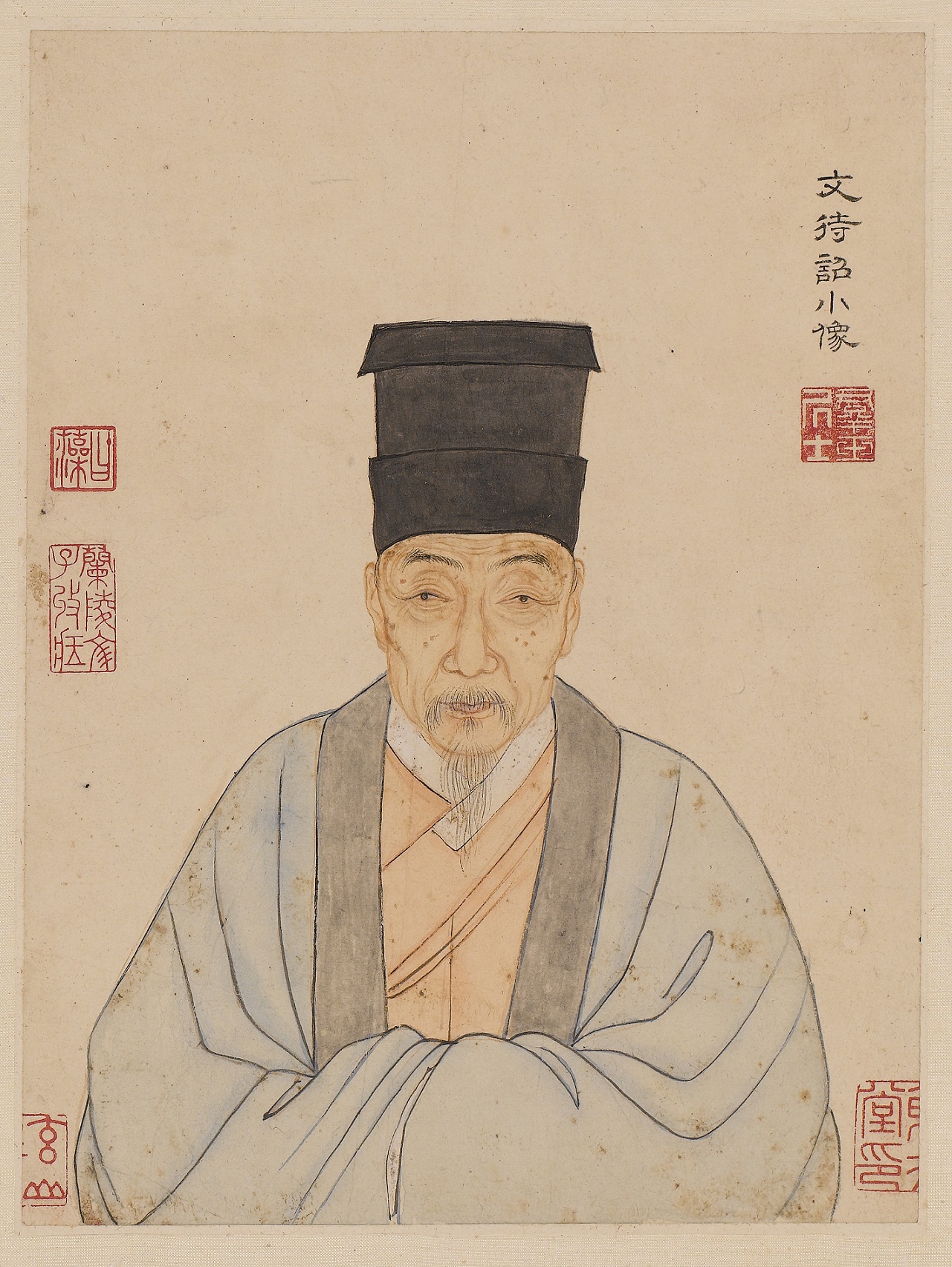
During the Mongol and Yuan Dynasties, the rulers ruled in a mixed manner under the premise of guaranteeing their own control rights, which created a new development environment for Jiangnan.
Based on the Jiangnan native land, the disadvantages in political status and freedom and independence in a pluralistic society set off the mature cultural traditions in the Jiangnan region. "Southern people", especially the Jiangnan scholar class, found a "self-adaptive" method under the rule of Mongolia and Yuan Dynasty in the strong cultural self-esteem and value self-confidence, and emphasized tradition and even went "retro" in terms of secular life and aesthetic style. , the subject consciousness has been continuously enhanced, and the humanistic core since the Song Dynasty has been able to continue and develop through the Yuan Dynasty, and has a more tenacious character. Most of the cultural elements and characteristics of Jiangnan since the Ming and Qing Dynasties can follow its traces to the Yuan Dynasty.
The Suzhou Museum once held a special exhibition of "Jiangnan in the Yuan Dynasty". The content of the exhibition was positioned to display the regional culture of this specific period. In addition to the famous calligraphy and painting works and arts and crafts of the Yuan Dynasty, it also displayed many cultural relics of the Yuan Dynasty discovered in archaeology. . This article was written by Xie Xiaoting, curator of Suzhou Museum, and Huan Xiaoxian, a researcher.
Jiangnan is a relatively special regional concept, which has different directions in different contexts and different times. Mr. Zhou Zhenhe once combined historical documents, administrative divisions, and social contexts to enumerate the evolution and changes of Jiangnan in each dynasties from the Qin and Han Dynasties to the Ming and Qing Dynasties, but he did not mention Jiangnan in the Yuan Dynasty in his review. As a unified regime that inherited the Southern Song Dynasty and later initiated the Ming Dynasty, the rulers of the Mongol and Yuan Dynasties moved south from the northern grasslands, continuing the context of regional historical evolution, and also bringing about collisions at the social and human level, forging a Jiangnan that belonged exclusively to the Yuan Dynasty.
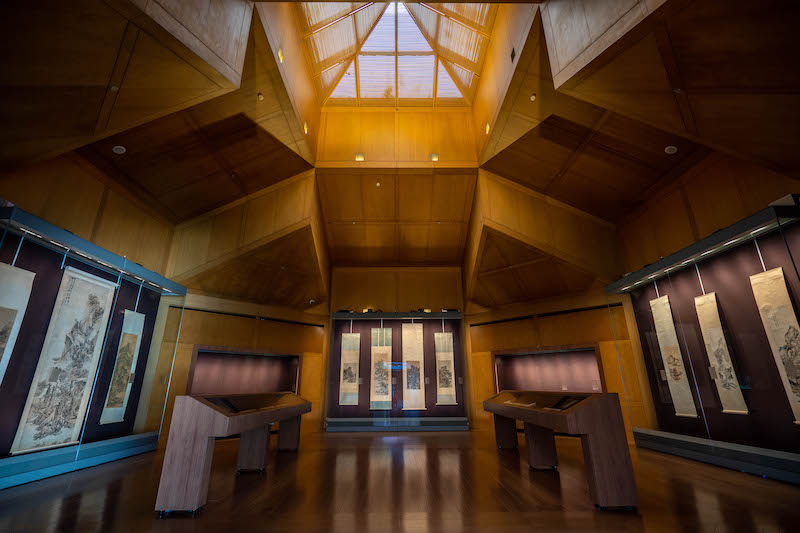
Suzhou Museum "Jiangnan in the Yuan Dynasty" special exhibition "Jiangnan Impressions Nostalgia" exhibition hall
1. Determination of "Jiangnan in Yuan Dynasty"
Zhou Zhenhe believes that "a more precise concept of Jiangnan was not finally formed until the Tang Dynasty". Emperor Taizong of the Tang Dynasty divided the world into ten roads based on the principle of mountains and rivers, and named them according to their geographical location. One of them was called "Jiangnan Road". The "Jiangnan" area in the "Jiangnan" area thus endows "Jiangnan" with a formal official context from the level of administrative division. During the reign of Emperor Xuanzong Kaiyuan, the world was further divided into fifteen roads, and Jiangnan Road was divided into Jiangnan East Road (Li Suzhou), Jiangnan West Road (Li Hongzhou, now Nanchang, Jiangxi) and Qianzhong (Li Qianzhou, today Chongqing), and the division of administrative regions In more detail, the scope of divisions that retain the word "Jiangnan" has been narrowed, which is roughly today's Jiangsu, the south of the Yangtze River in Anhui, and Zhejiang, Fujian, Jiangxi, and Hunan. It was during the Tang Dynasty that the prosperity and affluence of the Jiangnan region began to leave a deeper impression on people, and related images appeared frequently in literary works. In the Northern Song Dynasty, the area was roughly divided into Liangzhe Road, Fujian Road, Jiangnan East Road, Jiangnan West Road and Jingnan South Road; in the Southern Song Dynasty, Liangzhe Road was further divided into Liangzhe East Road and Liangzhe West Road.
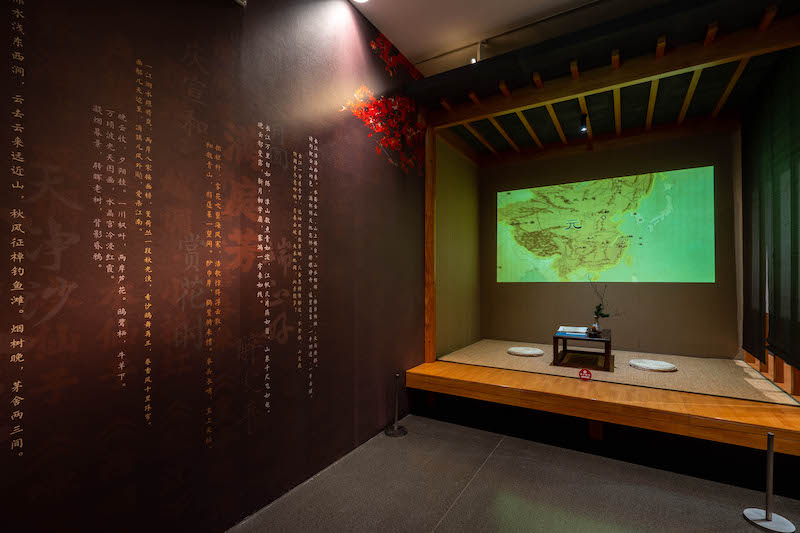
Preface Hall of the Special Exhibition "Jiangnan in the Yuan Dynasty" of Suzhou Museum
From the Song Dynasty to the Yuan Dynasty, the first-level administrative division "road" was changed to a province, and four levels of road, prefecture, prefecture, and county were placed under it. The names of provinces and roads were searched, and the word "Jiangnan" was not found. However, after a comprehensive inspection of its governance system, the Yushitai was established as the supervisory office in the Yuan Dynasty, and there were two xingyutai in the local area. Daoxing Yushitai" (referred to as "Jiangnan Xingtai" or "South Terrace"). Jiangnan Xingtai began in the fourteenth year of the Yuan Dynasty (1277): "Song Jiping country, because of its vast territory, may not be able to reach it, and set up Xingtai in Weiyang, using the three provinces to unify all Dao, that is, today Jiangnan Dao Xingyu Shi Taizhi is also in the celebration." Among them, "three provinces" refer to the three provinces of Jiangsu, Zhejiang, Jiangxi, and Huguang, "Weiyang" refers to Yangzhou, and "Jiqing" refers to Jiqing Road (now Nanjing) in Jiangsu and Zhejiang provinces. From Yangzhou to Jiqing, Jiangnan Xingtai has experienced several relocations. When the Jiangnan Xingtai was established, Yangzhou was the seat of the Jianghuai Province. In the 21st year of the Yuan Dynasty (1284), the Jianghuai Province moved to Hangzhou due to the need for governance. Jiangsu and Zhejiang Provinces, Jiangnan Xingtai moved to Hangzhou during this period. Later, due to changes in administrative divisions and administrative offices, Jiangnan Xingtai changed places several times until the Jiankang Road (renamed Jiqing Road in 1329) in Jiangsu and Zhejiang Provinces was stable in the 29th year of Zhiyuan (1292). down. From the end of the Yuan Dynasty to the sixteenth year of Zhengzhou (1356), when it was moved to Shaoxing, the Jiangnan Xingtai was established in Jiangsu and Zhejiang provinces for more than 50 years, which shows the significance of Jiangsu and Zhejiang to Jiangnan in the Yuan Dynasty. Yan Fu, a native of the Yuan Dynasty, once asserted: "Only in the upper reaches of the southeast of Zhejiang and Zhejiang provinces, with the Jinjiang River and the lake, can control the overseas tribes, trade and relocation with the masters of the city and boats, and the yearly income with the familiarity of Suhu Lake. The city, with hundreds of millions of cashiers, is the foundation of the south of the Yangtze River. If the two Zhejiang provinces are built, the south of the Yangtze River will be safe, and if the south of the Yangtze River is safe, the imperial court will not have to worry about going south.”
Under the Xingtai, there is also an inspection department (later changed to the Suzheng Lianfang Department), one department governs one department, and is also divided according to geographical advantages. Among the ten roads under the jurisdiction of Jiangnan Xingtai, there are Jiangnan Zhexi Road, Zhejiang East Haiyou Road, Jiangdong Jiankang Road and Fujian Minhai Road. Among them, Jiangnan Zhexi Road (commonly known as "Zhexi") named after "Jiangnan" was first set up in Lin'an (Hangzhou), and then relocated several times between Pingjiang (now Suzhou) and Hangzhou, supervising Hangzhou, Huzhou, Jiaxing, Pingjiang, Changzhou, Zhenjiang, Jiande Seventh Road, Songjiangfu, and Jiangyin Prefecture are roughly the same area as Liangzhe West Road in the Southern Song Dynasty; while the Jiangnan Xingtai Agency is located on Jiqing Road, taking Jiangdong Jiankang Road (commonly known in the Yuan Dynasty "Jiangdong") range, which governs Ningguo Road, Huizhou Road, Raozhou Road, Taiping Road, Chizhou Road, Xinzhou Road, Guangde Road and Qianshanzhou, which is roughly consistent with the area of Jiangnan East Road in the Southern Song Dynasty.
Therefore, in terms of the official governance context, Jiangnan in the Yuan Dynasty can broadly include the three provinces of Jiangsu, Zhejiang, Jiangxi, and Huguang under the jurisdiction of Jiangnan Xingtai—that is, today’s Jiangsu, Anhui, and the south of the Yangtze River in Hubei, as well as Shanghai, Zhejiang, and Fujian. Jiangxi, Guangdong, Hunan, Guizhou and other vast areas, among which, we can further focus on Jiangsu and Zhejiang provinces with special roles and status, especially the Jiangnan, Zhejiang West Road and Jiangdong Jiankang Road supervision areas within their jurisdictions.
2. Social features of Jiangnan in the Yuan Dynasty
The Mongolian Yuan Dynasty was the first unified regime established by ethnic minorities in Chinese history. Facing a vast territory and a complex environment, the rulers, on the premise of ensuring political, military, economic, and social control, implemented dual or pluralistic policies for all ethnic groups in the country. A new look of the times has been formed in the change and invariance.
(1) Sustained and prosperous economy
"Yuan History" has a cloud: "The capital of Yuan Dynasty is in Yan, and it is very far to go to the south of the Yangtze River. However, the number of houses of hundreds of officials, the guards and the people, all look up to the south of the Yangtze River ." It conveys the significance of Jiangnan to the Yuan Dynasty. In order to maintain its financial contributions, the Yuan Dynasty provided certain protection, guidance, encouragement and support to the economy of the south of the Yangtze River, and the prosperity and development trend of the economy of the Southern Song Dynasty continued.
After pacifying the south of the Yangtze River, Kublai Khan set up the Jiangnan Provincial Department of Farming and various provinces to encourage farming and farming in 1288 to investigate tax evasion and concealment of large agricultural assets, and strengthen the supervision and control of the Jiangnan farming area. However, the Xingda Sinong Division existed until 1295, when it was abolished, and the power of the agricultural officials was also weakened and supervised. The agricultural policies in the south of the Yangtze River were generally free and loose, and adapted to local conditions. In terms of tax system, different from the Ding tax and land tax in the north, the south followed the Song system to levy autumn tax and summer tax, and before 1296, except for Jiangdong and Zhejiang West, only autumn tax was actually collected, which minimized the impact of regime change on southern tax and grain . Not only that, but in 1288, the government "recruited people who are able to cultivate the open land and public land in the south of the Yangtze River, and they will be exempted from military service for three years, and one-third of their rent will be exempted." Encourage the people in the south of the Yangtze River to open up wasteland and engage in production, and even ordered that "in the future (Jianghuai and other places) registered scholars will pay business tax for business, pay land tax for farming, and all other miscellaneous duties will be exempted. Envoys and others are not allowed to settle down in the temple and harass them unreasonably." Coupled with the emphasis on water conservancy construction and the official issuance of agricultural books, the yield per mu of grain fields in the south of the Yangtze River has increased, and the annual income of the South-to-North Grain Transfer has also increased accordingly. According to historical data, the annual grain income of the Yuan Dynasty totaled 12,114,704 stones, of which Jiangsu and Zhejiang provinces accounted for 4,494,783 stones, accounting for 37.1%, ranking first among all provinces, and Jiangxi and Huguang provinces accounted for 9.56% and 6.97% respectively. More than half of the country's annual grain income has since opened the situation that "(Soochow japonica rice) is used to satisfy the country".

Suzhou Museum "Jiangnan in the Yuan Dynasty" special exhibition "Jiangnan Impression·Autumn Thinking" exhibition hall
Handicraft production was highly valued during the Mongol and Yuan Dynasties, and even the policy of "only craftsmen are exempt (dead)" was stipulated during the massacre of the city, and craftsmen were concentrated and distributed to various places for production. After the establishment of the unified regime, the government separated craftsmen from ordinary households, military households, station households and other household registrations. The craftsman registration was set up separately, and the identity could not be separated without government approval. Most of them worked in fixed bureaus and institutes established by the government and assumed professional The "artisan service" of the "craftsman" must complete the prescribed work tasks, but it is also exempt from general corvee service, enjoys the distribution of food and banknotes according to the law, and can be employed by others or sell his own works after completing the tasks. These craftsmen, together with military craftsmen and civilian craftsmen, supported the official handicraft production that directly served the ruling class. The official handicraft industry in the south of the Yangtze River was once led by the Ministry of Industry and Commerce. "There are more than 70 bureaus and courts, and coins, bows and arrows, armors, etc. are made every year." From the perspective of the categories involved in the bureaus and courts, we focus on the With traditional advantages in fields such as textiles, porcelain making, and salt making, cotton cloth is included in the Jiangnan summer tax yearly transportation range. The only porcelain making management organization serving the royal family, Fuliang Magnetic Bureau, is located in Jingdezhen, and Qingyuan Road belongs to the salt field. Salt production exceeds one million catties per year. At the same time, private handicrafts still exist. According to their production process, there are both family handicrafts and individual handicrafts. Some individual handicrafts are employed by government-run institutions, and some for-profit handicraft workshops have also emerged. The private handicraft industry in the south of the Yangtze River is more developed than that in the north, and it is unique in the fields of commercial trade and arts and crafts.
In the Southern Song Dynasty, commercial trade had developed significantly. After the reunification of the North and the South, the government opened the canal from Hangzhou to Dadu, "Jianghuai, Huguang, Sichuan, and overseas tributes, grain transportation, business travel, Maoqian, and Bida Jingshi". At the same time, a new shipping channel has been opened up, forming a sailing route starting from Liujiagang (now Taicang, Jiangsu), entering the sea via Chongming Prefecture, going northwards from Longtan (now Rudong, Jiangsu) all the way to Zhigu (now Tianjin), Yangcun ( Liujiagang, Qingyuan (now Ningbo, Zhejiang), and Ganpu (now Ganpu, Zhejiang) in Jiangsu and Zhejiang provinces became important ports. The water, land and sea transportation network covering the whole country has promoted the development of commodity trade. Grain and handicrafts have entered the field of circulation. New towns such as Wujiang, Kunshan, Changshu, Jiading, and Shanghai in Songjiang Province prospered accordingly. Foreign trade mainly exports products such as silk porcelain, pearls, emeralds and fragrant goods. Maritime trade was specially set up for the management of the Municipal Shipping Department. In 1277, when Jiangnan was established, there were four places in Quanzhou, Qingyuan, Shanghai, and Ganpu. Later, Wenzhou, Guangzhou, and Hangzhou were added. All are in the territory of Jiangnan. Ship merchants also mostly lived in ports in the south of the Yangtze River or nearby areas, such as the Yang family in Ganpu, the Pu family in Quanzhou, and Zhu Qing and Zhang Xuan in Taicang.
(2) Diverse and complex society
Reunification of regime, open area, convenient transportation, and economic prosperity have brought many new elements into the Jiangnan area. The arrival of the army, officials, businessmen, and religious figures has changed the membership structure of Jiangnan society and affected the life of Jiangnan people to varying degrees. Life.
1. Complex ethnic relations
The Mongol and Yuan rulers divided the ethnic groups into four categories: Mongols, Semu people, Han people (Han children), and Southern people. Among them, the Han people refer to the Han, Khitan, Jurchen, and Korean ethnic groups under the original Jin Dynasty, and the Southern people refer to the original people. Residents in the Southern Song Dynasty, Jiangnan in a broad or narrow sense can be roughly classified into this category. Because the government does not restrict the migration and communication of various ethnic groups, the types of ethnic groups in the Jiangnan area have rapidly enriched and live in a mixed manner.
The various ethnic groups in the south of the Yangtze River maintained the differences in order and status according to the Mongolian Yuan law, such as the severity of punishment and the distribution of local governance power. The selection of officials in the Yuan Dynasty was mainly based on selection and heredity. Southerners almost lost the possibility of advancing to the imperial court through their own efforts. Those who were recruited into officials, such as Zhao Mengfu, mostly appointed officials to the Imperial Academy, National History Museum, Guozijian, and even local Confucian institutions. , southerners cannot hold positions above the provincial and Taiwan levels, and the local officials in the south of the Yangtze River are mainly Mongolian, Semu, and Han people. In 1314, Yanyou resumed his studies, and Jiangnan students regained the traditional path of becoming an official. However, the strictly controlled scale of admissions, examination subjects differentiated by ethnic groups, and the uneven quota of admissions among regions all determined the The distribution of political power among the people is difficult to change fundamentally in the last generation. However, the local elites in Jiangnan have not completely lost their sense of existence. On the one hand, after the Yuan Dynasty destroyed the Southern Song Dynasty, the foundation of the big landlords in the south of the Yangtze River was not shaken, and they were even given certain protection and preferential treatment. The big landlords still retained their local economic and social status and influence; Low-level officials such as trainees and Confucian instructors are good at practical affairs, and their familiarity with local affairs plays a key role in actual governance. Mongolians and Semu people often rely on them. Therefore, in the social order at the grassroots level in the south of the Yangtze River, local elites can still exert a strong appeal.

Suzhou Museum "Jiangnan in the Yuan Dynasty" Special Exhibition - Yuan Sapphire Magic Square (Shanghai Museum) (inscribed Arabic numerals)
In addition to politics, the Yuan Dynasty respected the customs and habits of all ethnic groups in parallel, and did not impose unified norms. The "Dayuan Tongzhi" compiled and promulgated in the middle of the Yuan Dynasty also clarified the principle of "each according to its own customs". "Tongzhi Tiaoge" contains the "marriage etiquette system" article: "In February of the eighth year of the Yuan Dynasty, there was a section in the imperial decree: "People of all colors who marry each other of the same kind should follow the customary law; Most of them are men (except Mongolians)". This article recognizes and protects the traditional forms of marriage of various ethnic groups, and also shows that the government does not prohibit inter-ethnic marriages. In fact, intermarriage between officials of different ethnic groups in the Jiangnan area, between officials and businessmen, and wealthy households is very common. Affinal relationships are generally concluded based on social class. Among Mongolians and Semu people, scholars who are familiar with Han are more likely to be friendly with Han scholars. , which shows that the role of class distinction in social interaction is greater than that of ethnic groups. In the state of mixed living and free communication, the local residents and outsiders inevitably interact with each other, and some changes have taken place in the traditional social customs. The custom of "reducing iron" clothing and accessories in the south of the Yangtze River was once popular in the north: "In modern times, iron is still reduced, which is used as a decoration for wearing and knives, and the rest of the world competes with Qiantang and Songjiang. It is not an American play. This is a Jurchen legacy. , but the knife target and the saddle bridle can be used."
2. Diversified religious ecology
The religious policy of the Yuan Dynasty was unique in Chinese history. The government allowed all kinds of religions to spread freely in the territory, compiled religious household accounts such as monk households, Taoist households, and Yelikewen households, and granted corresponding taxation and civil litigation privileges. In the social status of common people, monks and Taoists ranked third and fourth among the ten occupational classes in the Yuan Dynasty, second only to officials and officials. Temples and Taoist temples not only occupied a large amount of land, but were also able to engage in commerce and handicrafts. These have created favorable conditions for the absorption of believers. There were also Li Kewen believers who used the privilege of avoiding servants to recruit civilian households as religious households. A large number of religious figures such as Christianity, Islam, Zoroastrianism, and Manichaeism poured into various parts of the south of the Yangtze River. While traditional religions continued to develop, they were affected to a certain extent. Various religions achieved a delicate balance in the coexistence.
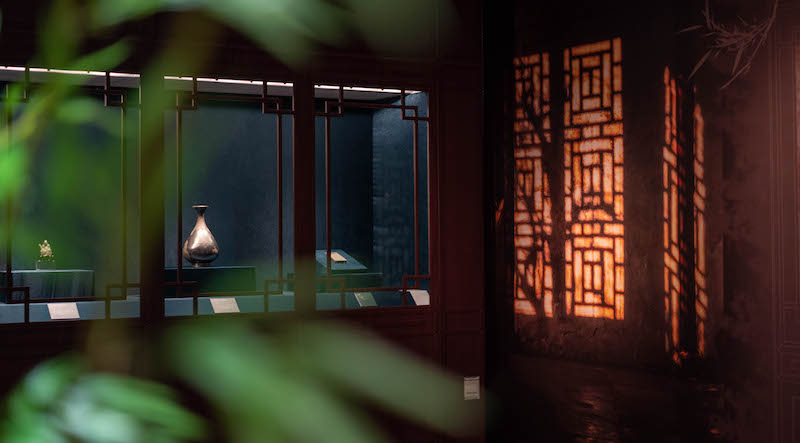
Suzhou Museum "Jiangnan Style in the Yuan Dynasty" special exhibition "Jiangnan Style Elegant Collection" exhibition hall
The development of Christianity and Islam is particularly remarkable. At that time, Christianity was transliterated into "Ye Li Ke Wen" by Mongolian transliteration. Its genres included Nestorianism and Catholicism. Catholicism had a Franciscan bishop in Quanzhou. Nestorians were mainly Nestorians, and they had a wider influence in Jiangsu and Zhejiang. , There are churches in Zhenjiang, Hangzhou, Yangzhou and other places. "Marco Polo's Travel Notes" once mentioned: "The place (Zhenjiang) also has two churches of Nestorian Christians, which were built in 1278 after the birth of Christ. ... The Great Khan appointed a baron named MarSarghis ruled the city for three years. He was a Nestorian Christian. During his three years in office, he built these two chapels, which still exist today. A chapel also". According to statistics, among the 3,854 overseas Chinese residences in Zhenjiang Prefecture in the Yuan Dynasty, there were 23 Yekewen households, 106 Yekewen households among the 10,555 people, and 109 Yekewen households among the 2,948 single people. The new development of Islam benefited from a large number of Muslims going south. There are mosques in Hangzhou, Suzhou, Nanjing and other suburban towns such as Songjiang, Jiaqing and Zhapu, and Hangzhou is a typical representative. There are a large number of Muslims in Hangzhou, and they mainly live in the third city. The layout of the city streets is similar to that of the Islamic area. There are 3 mosques in the city, and two iconic families, Anfani and Alodin, were formed. The latter was destroyed when the Song Dynasty was rebuilt. The Phoenix Temple in Hangzhou is still the center of worship and the main place for festivals in Hangzhou. The Sinicization of Islamic teachings was also completed in the Yuan Dynasty.
The Jiangnan area is known to have extensive influence mainly on Buddhism and Taoism. Buddhism in Jiangnan mainly practiced Zen, but Zen was not favored by the ruling class. Kublai Khan even supported Tibetan Buddhism. Zen policy, Zen was greatly impacted, and the trend of decline did not ease until Wenzong's period. Taoism in the south of the Yangtze River was relatively lucky. The Zhengyi faction and its branch Xuanjiao in Longhushan (in today’s Jiangxi) had close contacts with the imperial court. Xianyuan became the officially recognized head of the Nanbei Province faction. In addition to the differences of sects and popes, Jiangnan Buddhism and Taoism also had conflicts of interest with newly imported religions. In the eighth year of Dade (1304), Ye Li Kewen created a new head teacher on Wenzhou Road, recruited accountants without authorization, and seduced Taoist "Mr. Falu". After Dingfo and Taoists prayed, it was Yeli Kewen's turn, and he sent a note to the province to strictly restrain Yeli Kewen. In the fourth year of Zhida (1311), the Yunshan Temple and Juming Temple built by Ma Xuelijisi in Zhenjiang were changed into Buddhist "Prajna Temple" lower courts. Children and grandchildren should not fight, and those who fight will be punished with serious crimes." The dominant position of Buddhism and Taoism in Jiangnan has not been substantially threatened.
The integration and development of Confucianism, Buddhism and Taoism since the Song Dynasty was also continued and deepened in the Yuan Dynasty. Confucianism was included in the religious management system in the Yuan Dynasty, and Confucian households were organized, living allowances were paid, and labor and military service were exempted. The naturalization of Confucian households in Jiangnan was relatively looser than that in the north, and the number of households was larger. In fact, it played a key role in maintaining the scholar class in Jiangnan. The scholar class generally agrees with the concepts of Zen's purity and innocence, and Taoism's Taoism and nature. Their studies often combine the three religions, "according to Confucianism, relying on the old, and escaping from Zen." Unprecedented levels. Many literati in the south of the Yangtze River like to listen to Zen lectures, wear Taoist clothes, have frequent contacts with monks and Taoists, and some escape into Buddhism and Taoism. Zhao Mengfu likes to travel with Buddhist and Taoist figures, and there are many related works: "The View of the God of Fortune" (collected by the Palace Museum) volume records the whole story of the Taoist leader Zhang Weiyi appointing Cui Rujin to rebuild the Temple of the God of Fortune on the side of the West Lake Broken Bridge in Hangzhou; "Book" volume (collected by the Palace Museum) is a letter written to monk Zhongfeng, a key figure in Jiangnan Zen Buddhism; he also wrote inscriptions for temples in Longxing Temple, Linyin Temple, Guangfu Temple, etc. "Records" means that Zhao Mengfu was invited to write a book for Xuanmiao Temple in Suzhou. Today, there are still stone carvings based on it in the main mountain gate of Xuanmiao Temple. In his early years, Huang Gongwang, who made his living in official career, was introduced to Quanzhen Sect by Ni Zan’s elder brother Ni Zhaokui after he was released from prison. Snowy peaks and peaks" scroll (collected by the Palace Museum), which depicts nine famous Taoist mountains in the Songjiang area of the south of the Yangtze River with the freehand technique of ink and wash. There are also many Buddhist and Taoist clergy who practice Confucianism, are good at poetry and prose, and are good at calligraphy and painting. Originally a Taoist of the Maoshan School, Zhang Yu has strong calligraphy and excellent painting. He has many contacts with Zhao Mengfu, Yang Zai, Yu Ji, Huang Jin, etc. He is a close friend of Ni Zan, Huang Gongwang, Yang Weizhen, and Gu Yingyin. He is also a monk. As a friend, Yuan Jing, a monk from Lingyin Temple in Hangzhou, was mentioned in the volume of "Sending Oranges and Two Poems" in running script (collected by the Palace Museum).
3. The Humanities and Art of Jiangnan in the Yuan Dynasty
The changes in social style have profoundly affected the Jiangnan people who were born and raised in this country, and they have tempered the aesthetic customs and ideology with both regional characteristics and the atmosphere of the times.
(1) Differentiated development of arts and crafts
Due to the "temperature difference" between the Mongolian and Yuan rulers for different categories of handicrafts, the traditional arts and crafts styles in the south of the Yangtze River have embarked on different development paths according to the categories in the special handicraft production pattern and market supply and demand in the Yuan Dynasty.

Suzhou Museum "Jiangnan in the Yuan Dynasty" Special Exhibition - Yuan "Wen Xuanzao" Peony Ruyi Cloud Edge Calendula Holder (Nanjing Museum)

Suzhou Museum "Jiangnan in the Yuan Dynasty" Special Exhibition - Zhu Bishan Yincha Cup of Yuan Dynasty (Wu Culture Museum)
Metal crafts can be described as one of the most tightly controlled handicraft categories in the Yuan Dynasty. Miscellaneous crafts and utensils were set up in official workshops such as government offices and bureaus. The use of gold and silver among the people was also very popular. In order to strengthen control and control, the government did not prohibit folk fabrications, but in the 19th year of the Yuan Dynasty (1282), it was stipulated that "gold and silver craftsmen opened shops to build houses for opening and living. For making, the name of the craftsman is chiseled on it. It is not allowed to use gold and silver to make and sell it. If you have already made a vessel, go to Pingzhun warehouse to sell it. If you violate it, you will be arrested by the official, and you will be rewarded according to the gold and silver law. ". Therefore, gold and silver wares of the Yuan Dynasty are often inscribed by craftsmen. The bottom of the silver jade pot and spring vase unearthed from the tomb of Fan Wenhu in Anhui has a four-character regular script stamp of "Made by Zhang Zhongying". Government-made gold and silver wares are favored by the rulers and often have an obvious exotic flavor, such as jewelry and wine vessels. However, the style of folk gold and silver wares in the south of the Yangtze River is closer to that of the Song Dynasty, especially the stationery, dressing utensils, and daily utensils feature. Gold and silver daily necessities were unearthed from the tomb of Lu Shimeng in Wuxian County, Jiangsu Province, the tomb of Zhang Shicheng’s mother Cao’s family in Suzhou, and the tomb of Qianyu Qianyu in Wuxi. Among them, the gold wares unearthed from Lu Shimeng’s tomb have the inscription "Wenxuanzao" and the level of craftsmanship is very high. Even the common round utensils, Also hammer carved fine figures, flowers and birds. Compared with goldware, which is expensive and strictly regulated, the craft of silverware has developed more significantly, and a group of famous craftsmen have emerged. Zhu Bishan, a famous craftsman in Jiaxing, Zhejiang Province, is good at making exquisite silverware. Ke Jiusi, Yu Ji, Jie Musi, etc. have all asked him to make silver cups. Sitting and lying in Taoist robes, the literati are very interesting. In the Yuan Dynasty, copper was mostly used to make sacrificial utensils, daily utensils, seals, mirrors, etc. The utensils were rough, with patterns in between, and the shapes of the utensils were very fine. then".
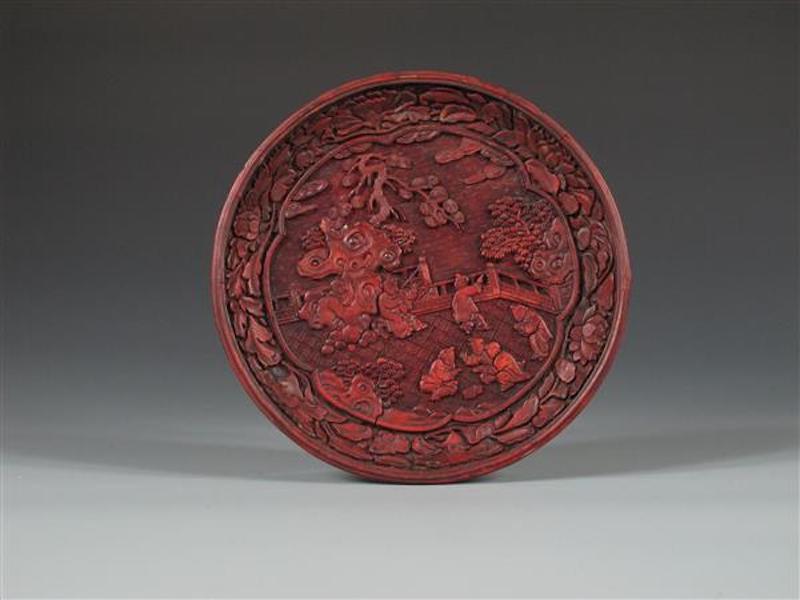
Suzhou Museum "Jiangnan in the Yuan Dynasty" Special Exhibition - Yuan Zhang Cheng made the red baby play plate (Zhejiang Provincial Museum)
Different from gold and silver wares, the rulers of Mongolia and Yuan Dynasty had little interest in lacquerware, and there were not many official workshops, while folk lacquerware developed at a high level, with Jiaxing, Hangzhou, Wenzhou and other places in Jiangsu and Zhejiang as important representatives, and Jiaxing carved lacquerware with extremely high achievements . Jiaxing carved lacquer inherits the prosperity of the Southern Song Dynasty. The skill of picking red is particularly exquisite, and there are many famous craftsmen. Zhang Yingwen in Ming Dynasty wrote in "Qing Secret Collection": "In Yuan Dynasty, Zhang Cheng and Yang Mao were good at their skills for a while. Knock Crack". Among them, Zhang Cheng's works are rich in paint, round in grinding and fine in carving, while Yang Mao's works are known for their clear Tibetan fronts and soft lines. Due to less interference, the style of Yuan Dynasty lacquerware did not change much, and the color tone was simple and harmonious. The composition and artistic conception tend to the aesthetic consciousness of Jiangnan literati. A round box with a picture of picking chrysanthemums in the east fence unearthed from the tomb of Ren's family in Qingpu, Shanghai (collected by the Shanghai Museum). In the center of the box is carved an old man wearing a hood and robes, walking with a stick, followed by a servant boy, holding the chrysanthemum in both hands. Holding a pot of blooming chrysanthemums conveys the meaning of "picking chrysanthemums under the eastern fence and seeing Nanshan leisurely", which is in harmony with the reclusive mentality of the literati at that time.

Suzhou Museum's "Jiangnan in the Yuan Dynasty" special exhibition—Yuan blue and white plum vases with peony patterns (Nanjing Museum)
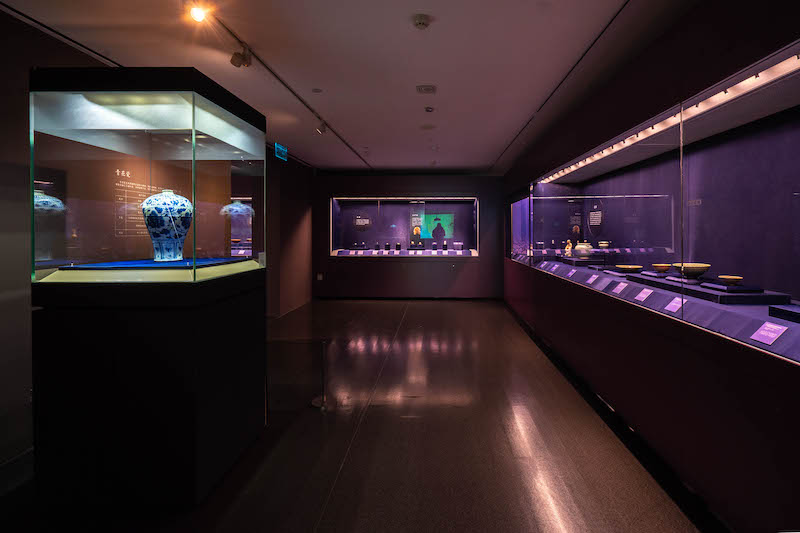
Suzhou Museum "Jiangnan Style in the Yuan Dynasty" special exhibition "Jiangnan Style·Scenery" exhibition hall
Developments in the field of porcelain were particularly special. In the government-run handicraft industry system, the number of porcelain organ workshops is the smallest. The only porcelain management agency serving the royal family in the country is the Fuliang Ciju Bureau in Jingdezhen. The scale is small, and the rank of the chief is not high; In circulation trade, the government encourages private production and taxes it. The most recognized types of official porcelain in the Yuan Dynasty are the die-printed double-horned five-clawed dragon and the exquisitely crafted "Taixi", "Dongwei" and "Shufu" egg white glaze wares, among which the "Shufu" porcelain is mostly recognized as Fuliang The magnetic bureau is a set product for the Privy Council. In addition to Jingdezhen, Longquan Kiln and Ge Kiln, which belong to Jiangsu and Zhejiang provinces, have extensive influence on the firing of Jiangnan folk kilns. Under the coexistence of official and folk kilns, the dual characteristics of Jiangnan porcelain are also highlighted in the fact that the aesthetic taste of local scholars and the fashion style of foreign ethnic groups have their own markets. Ge kiln celadon imitates the style of the Southern Song Dynasty. The shape of the celadon is mostly small, the surface is plain and without grain, exquisite and concise, elegant and generous. Because Muslims favored celadon, Longquan celadon began to appear in large-scale vessels, with richer decorations, with obvious religious and folk colors in the decoration content, and more majestic and full in shape. The well-known Yuan Qinghua is mainly produced in Jingdezhen. Due to the demand of the West Asian market and the enthusiasm of domestic Muslims, it began to rise, and soon gained widespread love and a huge overseas market. It is a typical "hybrid". Blue and white porcelain is made of cobalt blue raw materials from West Asia. The color is close to the white and green styles of Mongolians and Muslims. The production technology largely inherits Song porcelain; There is also a stem cup shape that is not common in Song porcelain; the pattern layout is very dense due to the influence of Muslim culture, but the pattern theme is also common in Song porcelain. The blue and white plum vase is decorated with the pattern of "Xiao Heyue Chasing Han Xin".
(2) Inheritance and development of literati life and artistic creation
After entering the Yuan Dynasty, the literati in the south of the Yangtze River, who were dominated by the scholar class, experienced particularly severe changes in their hearts. The change of regime not only made them marginalized in the political society and lost the opportunity to be useful in the world, but also brought about the differences between Yi and Xia. Differences in ideology and culture and even differences in values. Due to the sudden gap, the literati in the south of the Yangtze River struggled in conflicts between being born and joining the world. Some of them diligently pursued official positions in order to revive the road of "Gangji", while some retreated to devote themselves to scholarship, Buddhism, poetry, calligraphy and painting. However, no matter whether they were born or entered the world, Jiangnan literati always adhered to their inner cultural self-esteem and value identity, and emphasized their own individuality and valued their own emotions in a diverse and complex political and social environment. As a result, Jiangnan's literary style became more intense, literati's life became more elegant, and their literary and artistic creations also had a greater impact. new features.
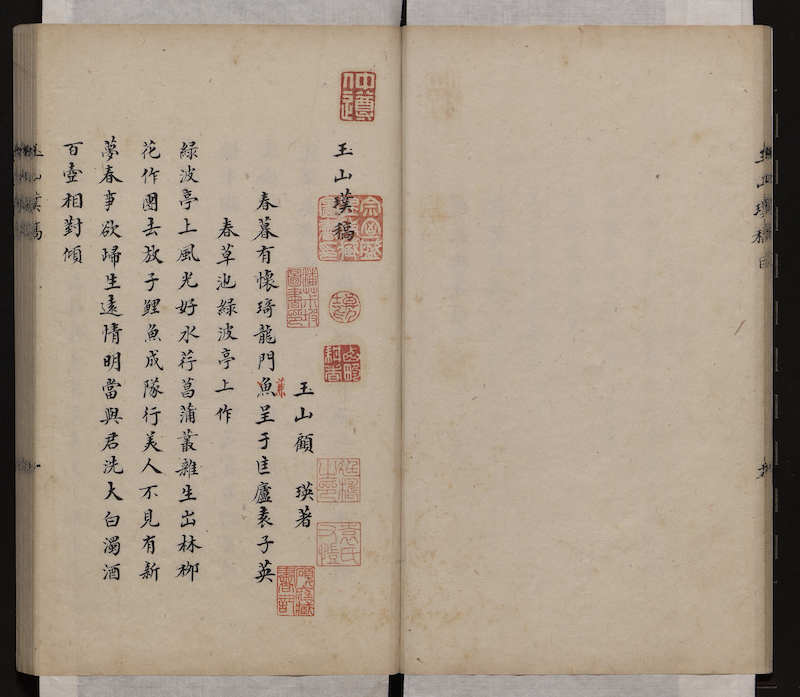
Suzhou Museum's "Jiangnan in the Yuan Dynasty" Special Exhibition - Yuan Guying's "Yushan Pu Manuscript" (Qing manuscript) (National Library of China)
The gatherings of literati, such as the Orchid Pavilion in the Eastern Jin Dynasty, the Jingu Garden in the Western Jin Dynasty, and the Western Garden in the Northern Song Dynasty, ushered in a prosperous situation in the south of the Yangtze River in the Yuan Dynasty. In the early Yuan Dynasty, Poetry Clubs and Gatherings flourished in the Jiangnan area following the legacy of the Southern Song Dynasty, and a large number of reclusive literati gathered in Hangzhou and other places. Unlike Tianqing Temple Gatherings and Wanliutang Gatherings, which are centered on Dadu and have a strong official background, the Gatherings in the south of the Yangtze River are separated from official social etiquette. Talking about forests and valleys, it seems more wanton and relaxed. Gao Kegong, Xian Yushu, Li Jin and other northern scholars also freely and equally entered and exited Yazhong, and had close contacts with Jiangnan scholars. With the passage of time, the literati gatherings in the south of the Yangtze River became more and more mature, especially some wealthy businessmen provided economic and venue support for the gatherings, and the scale and influence continued to expand. At the end of the Yuan Dynasty, Cao Zhibai’s Cao’s Garden in Songjiang, Yang Qian’s Buying Yunshan Building in Huating, and Gengyuxuan in Xu Dazuo in Wu County all gathered literati and scholars from the famous side. Lu Liangzuo’s Yingkui Wenhui and Pu Lexian’s The Gui Wenhui convened Jiangnan literati to comment on their essays. Yang Weizhen and the Tie Ya Poetry School, Gao Qi and the Beiguo Poetry Society also continued to develop during the assembly. Kunshan Guying’s Yushan Gathering reached its peak and lasted for about 20 years in the chaotic current situation. There were no less than a hundred gatherings, and the participants included Han, Mongolian, Xixia, Huihui and other ethnic groups. Courtiers, academic officials, celebrities, Shi Tao, craftsmen, voice performers, Ke Jiusi, Yang Weizhen, Wang Meng, Ni Zan, Zhang Yu, Shi Liangqi, Zhang Wo, Zhao Yuan, Nie Yong, Sadura, Angji, Tai Buhua They all once traveled with Gu Ying. Yushan Elegant Collection is one of the representatives of literati collections in the late Yuan Dynasty and even in the history of China because of its victory in gardens and pavilions, the large number of participants, the length of duration, and the abundance of creative works.

Suzhou Museum's "Jiangnan in the Yuan Dynasty" Special Exhibition - Zhao Tianyu, Ke Jiusi and other seven gentlemen in the Yuan Dynasty (Suzhou Museum)

Suzhou Museum "Jiangnan in the Yuan Dynasty" Special Exhibition - Tsinghuayan Yushan Collection Axis (Taipei National Palace Museum collection) (picture exhibit)
The main forms of activities of the Yuan Dynasty Literati Gatherings were amusement in mountains and rivers, cups and banquets, poetry, calligraphy and painting, appreciation of ancient books, playing musical instruments, singing and dancing games, making tea and drinking tea, all kinds of worldly pleasures, and full of literati. The interest reflects the secular taste and aesthetic style of the literati here. In the early stage of the collection, the collectors were "drunk and jovial, competing with each other", but in the middle stage of development, it was "talking about joking and joking, starting and ending singing songs, each with his own interest". Happy mess. Literati gradually let go of their inner frustration, enjoyed leisure and interest in secular games, and expressed their personal emotions, resulting in the birth of a large number of unique poetry, calligraphy and painting works. As far as the creation of poetry and prose is concerned, except for a few words reflecting the chaos of the war, most of them are instant events, reciting the haze of business, reminiscing about life experience, conveying real and natural emotions and thinking about life. The form of the work is free, "songs are in harmony with each other, mixed in length and length, and there is no such thing as extravagance". Under the influence of Yaji, the style of poetry in the late Yuan Dynasty changed profoundly, and "Tieya style" developed rapidly. "Tieya style" takes Yang Weizhen as its sect, abandons the shackles of rhythm, and takes the more free and unrestrained ancient Yuefu as its main style. It often has strange ideas and uses strange images to express the poet's thoughts and emotions. Therefore, it is aesthetically strong and infectious. Strong and distinctive. Through more personal works, we can see a literati group with flamboyant personality, broad-mindedness, sincere feelings and strong self-awareness.

Suzhou Museum's "Jiangnan in the Yuan Dynasty" special exhibition - Yuan Zhao Mengfu's Prajna Paramita Heart Sutra (collected by Liaoning Provincial Museum)
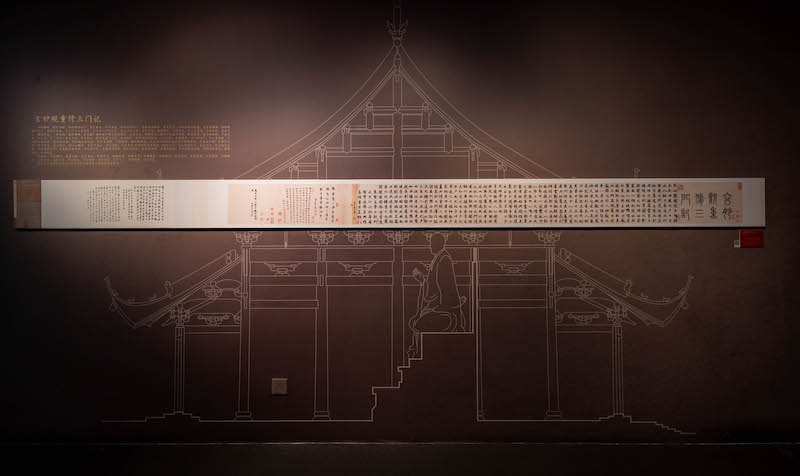
Suzhou Museum "Jiangnan in the Yuan Dynasty" special exhibition "Jiangnan Style·Faith" exhibition hall - Zhao Mengfu's "The Story of the Reconstruction of the Three Gates of Xuanmiao Temple"
Literati painting is another "retro" move of Jiangnan literati in the Yuan Dynasty. After the fall of the Southern Song Dynasty, the painting academy was abolished, and literati replaced court painters as the main force of painting. At this time, painting was not a ladder for literati, nor was it a status symbol attached to self-cultivation, governance, and peace. A medium for expressing inner emotions and realizing free entertainment. Zhao Mengfu's advocacy of the retro style of painting was the beginning of the rise of literati painting. He flaunted ancient ideas, advocated the imitation of nature, and used the aid of ancient painting as a starting point to reform the ancient system. Integrating with poetry and book printing, the number of inscriptions and postscripts of paintings generally increased. Zhao Mengfu's "Dongting Dongshan Map" axis (collected by Shanghai Museum) depicts the scenery of Dongting Mountain in the east of Taihu Lake, inheriting the clean and soft brushwork of Dong Ju's painting school in the south of the Yangtze River. The people are completely different. On the upper right of the painting, there is also a poem inscribed by myself, signed "Zi'ang", and engraved with "Zhao Zi'ang's" Zhu Wenyin, forming another new look of Yuan paintings. Zhao Mengfu completed the construction from theory to practice in the field of calligraphy and painting, which laid the foundation for the development of literati painting.

Suzhou Museum's "Jiangnan in the Yuan Dynasty" special exhibition - Yuan Huang Gongwang Fuchun Daling Map Axis (Nanjing Museum)
After Zhao Mengfu, literati painters in the south of the Yangtze River, represented by the Four Masters of the Yuan Dynasty, further pushed literati painting to maturity. They look for the source of creation in life, pay attention to the construction of the artistic conception in the painting and the expression of their own emotions. By giving the image a certain symbolic meaning, they convey subjective consciousness and personal emotions. During this period, many freehand works with the theme of Jiangnan landscapes and thatched cottages were born, constructing an elegant and delicate impression of Jiangnan for later generations. The axis of Huang Gongwang's "Tianchi Stone Wall" (collected by the Palace Museum) takes the scenery of Tianchi Mountain in Wuxian County, Suzhou City as the main object of creation. It is a work of Dong Ju's own method, with mountains and mountains, thousands of rocks competing for beauty, and clouds of smoke. Fluid and majestic; Ni Zan's "Autumn in Yuzhuang" (collected by Shanghai Museum) was painted when he abandoned his home and fled. At that time, the society was in turmoil and personal fortunes turned from prosperity to decline. The work depicts trees on gentle slopes in the foreground and gentle mountains in the foreground Qiu, the large section of the middle ground is blank to show the calm lake surface, and the "three-section" composition creates an empty and distant artistic conception and a lonely and desolate state of mind; The scenery of the mountains shows the characteristics of the mountains and mountains in the south of the Yangtze River. The whole picture is thick and ancient. The turning point and innovation of this era will have a great influence on later generations. Through the collective art practice of Jiangnan literati painters, literati paintings replaced courtyard paintings and established the mainstream position in the history of Chinese painting, which has continued to influence Chinese painting circles for hundreds of years. The predecessor of the school of painting.
Four. Conclusion
The control of the society by the rulers of the Mongolian and Yuan Dynasties is mainly reflected in the absolute control of military power and differentiated political treatment. During this period, Jiangnan maintained excellent productivity, unearthed huge commercial capabilities, attracted many outsiders, had a highly dense population, and had an unprecedentedly active society. However, most outsiders are not interested in "Sinicization" like the Mongolian and Yuan ruling class. They live according to "local customs" and show their own ideas and aesthetic styles. The coexistence of multiple ethnic groups and religions is more like sharing the Jiangnan. An open and prosperous space, in which to seek their own interests and values, communicate with each other but it is difficult to truly integrate.

Suzhou Museum "Jiangnan in the Yuan Dynasty" Special Exhibition (December 22, 2021-March 22, 2022) Poster
On the other hand, based on the Jiangnan region, the disadvantages in political status and freedom and independence in a pluralistic society set off the mature cultural traditions in the Jiangnan area. "Southern people", especially the Jiangnan scholar class, found a "self-adaptive" method under the rule of Mongolia and Yuan Dynasty in the strong cultural self-esteem and value self-confidence, and emphasized tradition and even went "retro" in terms of secular life and aesthetic style. , the subject consciousness has been continuously enhanced, and the humanistic core since the Song Dynasty has been able to continue and develop through the Yuan Dynasty, and has a more tenacious character. Most of the cultural elements and characteristics of Jiangnan since the Ming and Qing Dynasties can follow its traces to the Yuan Dynasty. Since the beginning of the Yuan Dynasty, the cultural center has gradually existed independently of the political center, forming a relative pattern with the political center, preserving the context and laying the foundation for the prosperity of Jiangnan culture in the Ming and Qing Dynasties and even today.
(The original title of this article was "The Social Style and Humanistic Character of Jiangnan in the Yuan Dynasty", and the notes were not included when The Paper published it.)


